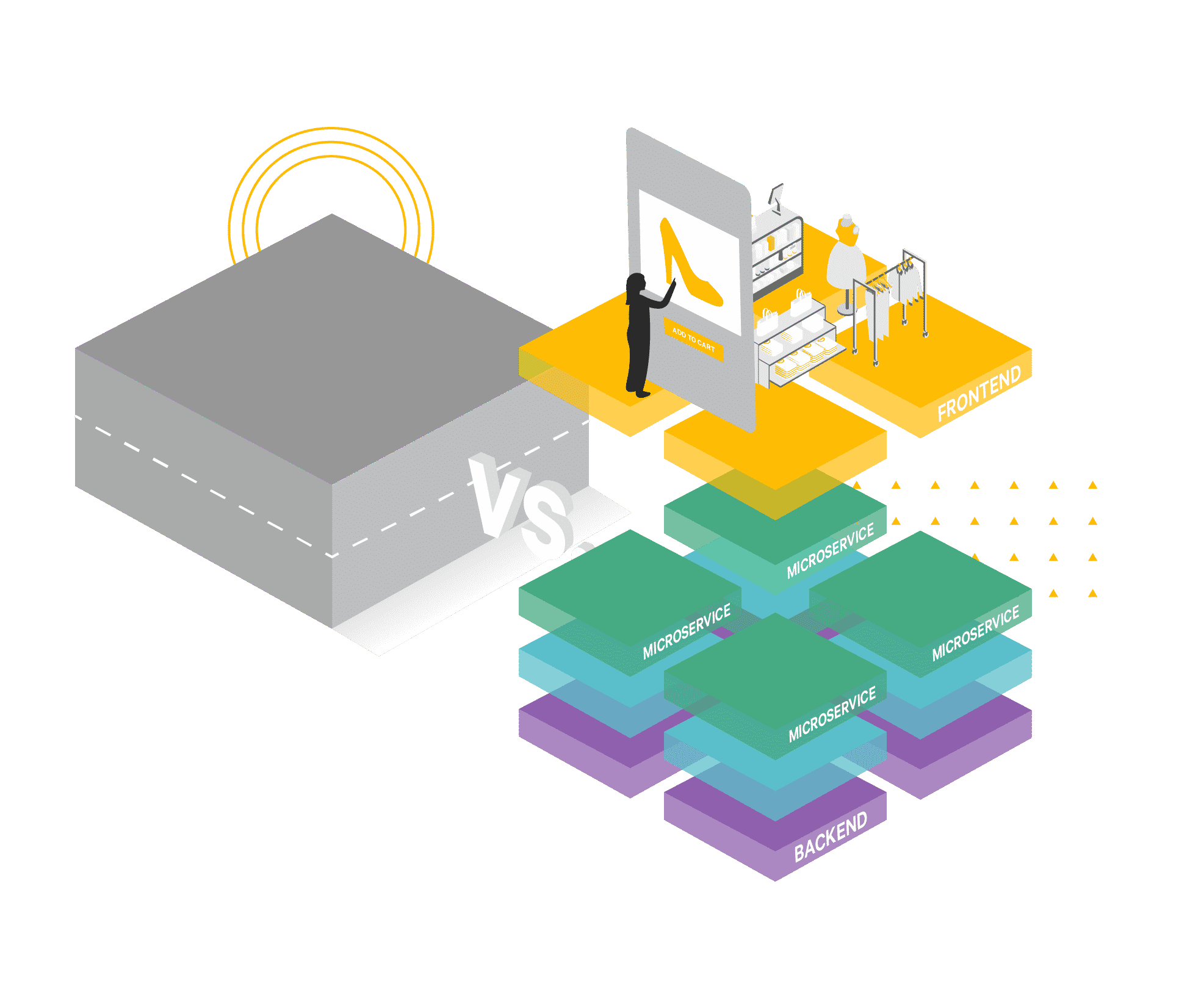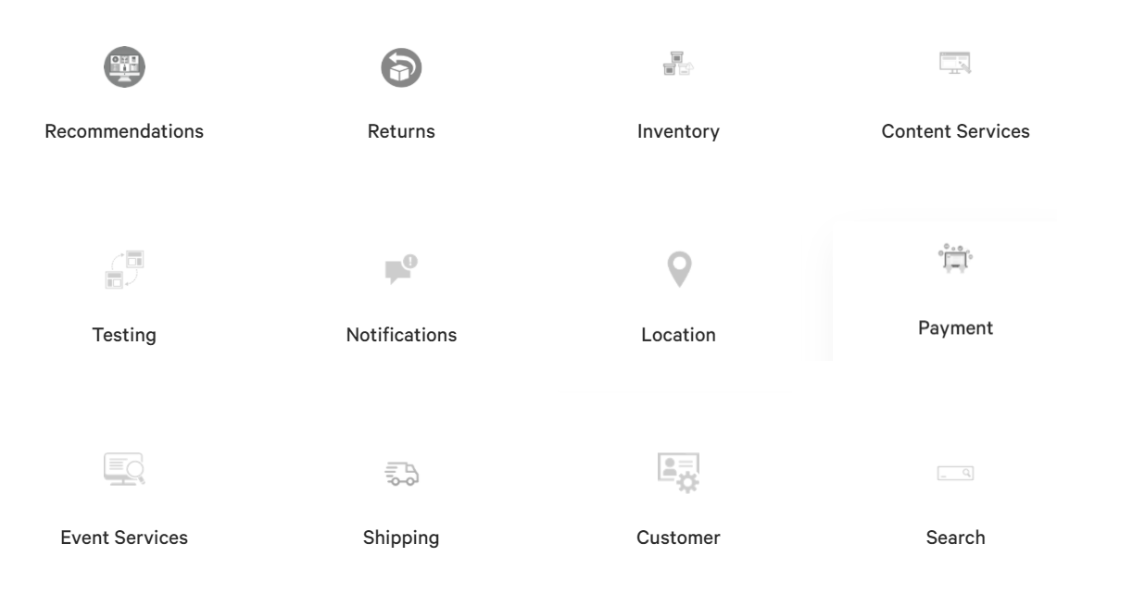What are eCommerce microservices and why care about them?
 AJ Leale
AJ Leale
This article will provide a high level explanation of microservices and how they will transform development of eCommerce sites. It will discuss the trends and direction of this technology and explain the power it provides to developers and companies.
What is a microservice?
Microservices are just as the word describes; small independent services or modules that communicate to systems through defined APIs. A simple online product catalog will need many microservices to fully expose all the inserts, updates and deletes needed to manage and display products.
What trends are we seeing with microservices?
Many businesses are moving to microservices-based solutions for scalability, agility, and reduced downtime, among other things. Globally, 85% of enterprise businesses currently use microservices, with the rate of adoption also high among mid-sized businesses at about 75-84%.
Companies like Netflix, Uber, Etsy, and Amazon have long known that microservices provide advantages over traditional monolithic systems, particularly when it comes to eCommerce.
Microservices enable Ecommerce businesses to move away from the rigid all-in-one monolithic systems that make it difficult, if not impossible, to keep up with changing trends in consumer shopping behaviors, expectations, and the need for seamless omnichannel experiences.
How does it make development easier?
The key benefits of moving to a microservices approach make it possible to deliver exceptional omnichannel shopping experiences quickly. Since a microservices-based architecture is a modular approach to designing eCommerce software, all services within the software solution operate independently of each other.
This differs from monolithic eCommerce systems where the core features (e.g., shopping cart, product listings, payment processing, fulfillment, etc.) are linked to the frontend user interface. In addition, updates and revisions to backend functions can impact frontend user experience, create website downtime and slow down the entire development process and monolithic systems also limit your ability to customize functions and respond quickly to changing trends and new technology.
With microservice-based eCommerce, new functionality can be added incrementally and each function operates independently from the others. This allows developers to build or customize the platform in an agile way, incrementally adding more services and capabilities as the project continues..

Examples of some of microservices available in Kibo’s platform
Developing microservices-based eCommerce
Developers can use microservices to evolve and extend their eCommerce capabilities quickly and deliver faster results to the business. They are more able to experiment with new functionalities, technologies, and capabilities.
Some key benefits of microservices-based eCommerce include:
Debugging: Since microservices operate independently of each other, they can be debugged separately from the larger platform ecosystem.
Stability: Separation of microservices gives more stability overall, since trouble with one microservice will have minimal or no impact on the larger system. Each microservice can be developed, tested, and launched independently without risking stability of the platform. Downtime is reduced as a microservices approach minimizes total system failure if something goes wrong with one service.
Technology independent: Developers can work with the platforms and languages they prefer, rather than limiting them to the eCommerce platform’s technology or programming language.
Modular development: Developers can test, build, test and deploy the latest Ecommerce technology without having to rebuild the entire system giving you the ability to test new technologies, architectures, and solutions quickly.
Reduced codebase complexity: Individual microservices are less complex to maintain and update because they’re decoupled from the larger system. With a monolithic system, the entire codebase needs to be updated for major changes. This isn’t the case with microservices which act as independent systems within a system.
Microservices-based eCommerce is flexible eCommerce. It allows businesses to deploy the products, services, and capabilities that make sense for their unique needs.
Why should you care about microservices-based eCommerce?
Online merchants are evolving towards a microservices approach as part of their headless strategy. It enables them to keep pace with rapidly changing customer expectations and competition in their industries. The flexibility and scalability of microservices helps developers meet customer omnichannel expectations and make it possible to “future proof” your commerce platform by adding to it when something else is available.
Consumers, faced with store closures and ongoing uncertainty are watching what they spend and are rewarding retailers who can deliver good shopping experiences. According to PwC, customers are willing to pay up to 16% more on products and services when they feel appreciated.
Consumers are also embracing hybrid methods of shopping like click-and-collect and buy-online-pickup-in-store (up 125% and 52% last year, per AdAge.) Using a microservices-based eCommerce approach empowers you to connect your commerce ecosystems across online and offline channels, and to deliver a unified customer shopping experience.
For developers, embracing the microservices revolution will give you superpowers to build and deliver exceptional connected shopping experiences, with applications that expand functionality while personalizing their shopping experience and driving revenue to your company.
Headless commerce platforms like Kibo decouple the eCommerce platform frontend (e.g., your online storefront) from the backend (your data and transactions layer).
Decoupled microservices support headless operations by providing the ultimate flexibility with customization and scalability. They allow you use only the products, services, and capabilities you need and scale up as you grow.
Kibo’s solution, flexibility, agility, and speed
Kibo’s unique microservices-based eCommerce architecture is part of our Unified Commerce Platform. We use shared services across all products including Kibo B2B and B2C Ecommerce, Kibo Order Management, Kibo Personalization, and Kibo POS products.
Since all products built in the Kibo Unified Commerce Platform share the same set of microservices, retailers can deliver personalized omnichannel customer experiences. This is possible thanks to a 360-degree customer view, centralized commerce technologies, and the ability to deliver industry-leading shopper journeys.
Our platform uses decoupled microservices to support headless operations, allowing for even more flexibility. You can future-proof your commerce approach and develop highly customized shopping experiences with Kibo’s microservices-based eCommerce platform. Learn how.
Subscribe to my newsletter
Read articles from AJ Leale directly inside your inbox. Subscribe to the newsletter, and don't miss out.
Written by
